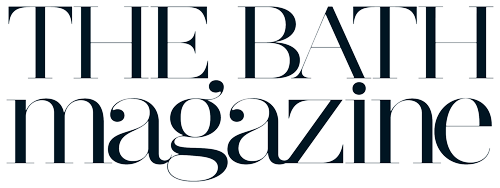The recently installed Art on the Street project at Milsom Quarter and Kingsmead Square was created by local artist Zoë Power. Funded by the West of England Combined Authority the Love Our High Streets programme features overhead flags, decorated planters, contemporary bunting and window designs. We ask Zoë about the project…
Tell us about the Art on the Street project and the pieces you created for Milsom Quarter and Kingsmead Square.
I was approached by Macgregor Smith, an architect firm working with Bath Council, with the brief and was asked to apply. I found out that my application was successful mid-June, so the project had a super tight turnaround as they wanted to go to print in July. The aim of the ‘Love Our High Streets’ programme is to increase footfall, revitalise and bring a sense of identity to the high street with bold and joyous artwork. The brief was totally up my (high) street!
How did you plan your ideas for the overhead flags, decorated planters, bunting and window designs?
There was certainly a lot of ground to cover! The aim of the artwork was to to highlight the city as a fashion and foodie hub and to mark some of the celebratory events that happen here, like Bath Carnival and The Great Bath Feast, which I used for inspiration. I wanted the artwork to feel consistent and bring a unifying identity to the city, so there was some repetition with certain design elements. I also wanted it to feel uplifting, playful and organic, so there are a fair amount of randomness, jazzy patterns and squiggles in there too!
Tell us about the concepts and motifs you used in the designs.
Milsom Street is a fashion, design and shopping destination, so the artwork there focuses on that and features sassy fashionistas and dancing carnival-goers. Kingsmead Square is such a summery hotspot for eating and drinking as well as watching street performers, which provided plenty of inspirational material to work with. I want my artwork to feel energetic and fun, so my characters are often jumping, dancing and posing. We can all get bogged down with our worries, jobs, to-do-lists – if I can inject a bit of silliness and play into someone’s day, then that’s a win.


How do you decide on the colours you use?
Making work for a public space is very different to work that’s framed in your living room. Trust me, I’ve made that mistake (my house is verging on garish!). These flags and planters really needed to pop against the urban concrete, limestone and – all too frequently – grey weather. Lots of the colours I’ve used here are tried and tested colours that I use in my murals. Bright purples, pinks and blues always look great and make us feel great too.
How do you create and produce the artwork?
I always start off in my sketchbook as I find it the best way to get ideas down, squiggle and explore. I then moved these sketches on to my iPad and worked them digitally, which was the best medium for this project as the final pieces were printed on a large scale and needed to be bold and crisp.
Our visual environment often depicts us (and particularly women) as passive consumers rather than active agents of change
Your bright, stylised work seems to suit public spaces. What is the appeal of producing work for such spaces?
I love people! I really get a kick out of talking to people, hearing their stories and bringing art to the masses. It’s so satisfying to transform a space from a run-down, unloved wall to become a free, public piece of art. It really does change how people feel about
where they live and work, can bring communities together and encourage a local sense of pride and belonging. I enjoy sitting down designing, but getting out, meeting people and painting really makes my heart sing.
What sort of other illustration work do you do?
I particularly enjoy working with socially and environmentally conscious brands and businesses. My work can be adapted to anything from T-shirt designs, beer-can labels, murals and window displays… the possibilities are endless. I’m currently exploring working in 3D and wood, and am keen to collaborate with architects and fabricators on urban interventions and sculpture.

Is your work more effective at a large scale?
Hmmm… not necessarily. I love making linocut prints and screen prints, which are a much smaller scale but these tend to be more muted. Bright colours and bold shapes are very eye-catching and memorable, which is what you want a mural to be, which has gradually led my style to adapt to the medium.
You always have people at the heart of your work. Has this always been an important element of what you do? When did this fascination begin?
I’m more of an extrovert than an introvert – I love a chat and meeting people, which is why mural painting suits me. As long as I can remember I’ve been curious about people, cultures and belief systems, which is what drew me to study an undergraduate degree in Anthropology. In terms of public art, I just felt that our visual environment often depicts us (and particularly women) as passive consumers, rather than active agents of change and I wanted to address that.
By presenting people in active poses, depicting a range of skin tones and body types, your work aims to be joyous and body positive.
My style is constantly evolving as I gather inspiration. My work has got bigger over time – amazing as I never dreamt I’d paint on such a huge scale. I want my art to be accessible and for people to connect to my artwork, to feel empowered and uplifted when they see it. After all, if we all felt better about ourselves, we’d probably act better towards each other and our environment. Making work in public is such a powerful platform and I want to make the most of that, to re-write the narrative and the beauty standards we often see slapped across billboards and TV screens. Power to the people!


